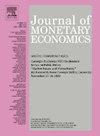能源价格冲击、失业和货币政策
IF 4.3
2区 经济学
Q1 BUSINESS, FINANCE
引用次数: 0
摘要
能源价格飙升对失业者的打击比对就业者的打击更大,货币政策是否面临着稳定通胀和失业之间的权衡?来自欧元区消费者预期调查的数据显示,失业不仅迫使工人降低消费,而且将更高比例的消费用于能源。我将这一证据纳入了一个具有劳动力市场摩擦的可操作性异质代理新凯恩斯模型,在该模型中,能源既是生产中的补充投入,也是一种非同调消费品。由于保险不完善,失业迫使工人减少消费,而且由于偏好是非同调的,他们会将更大的消费份额分配给能源。劳动力受能源价格上涨影响的异质性导致了货币政策的内生性权衡:最佳应对措施包括部分放宽通胀,以限制失业率的上升,从而防止工人受到更大的冲击。本文章由计算机程序翻译,如有差异,请以英文原文为准。
Energy price shocks, unemployment, and monetary policy
Does monetary policy face a trade-off between stabilizing inflation and unemployment as soaring energy prices hit the unemployed harder than the employed? Data from the euro-area Consumer Expectations Survey show that job losses not only force workers to lower their consumption but also to devote a higher proportion of it to energy. I incorporate this evidence into a tractable heterogeneous-agent New Keynesian model with labor market frictions, where energy acts as both a complementary input in production and a non-homothetic consumption good. Unemployment forces workers to consume less due to imperfect insurance and, since preferences are non-homothetic, to allocate a larger consumption share to energy. The heterogeneous exposure of the labor force to rising energy prices induces an endogenous trade-off for monetary policy: the optimal response involves partly accommodating inflation to limit the increase in unemployment and, hence, prevent workers from becoming more exposed to the shock.
求助全文
通过发布文献求助,成功后即可免费获取论文全文。
去求助
来源期刊

Journal of Monetary Economics
Multiple-
CiteScore
7.20
自引率
4.90%
发文量
90
审稿时长
74 days
期刊介绍:
The profession has witnessed over the past twenty years a remarkable expansion of research activities bearing on problems in the broader field of monetary economics. The strong interest in monetary analysis has been increasingly matched in recent years by the growing attention to the working and structure of financial institutions. The role of various institutional arrangements, the consequences of specific changes in banking structure and the welfare aspects of structural policies have attracted an increasing interest in the profession. There has also been a growing attention to the operation of credit markets and to various aspects in the behavior of rates of return on assets. The Journal of Monetary Economics provides a specialized forum for the publication of this research.
 求助内容:
求助内容: 应助结果提醒方式:
应助结果提醒方式:


